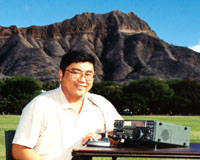
Emergency Communications in Hawaii Using Amateur Radio
Amateur radio is known as one means of providing quality radio communications during times of emergency. The Feb. 15 issue, "How Amateurs Accomplish the Impossible During Disasters" explored the aspect of amateur radio teamwork. This month, we look at the nature of the medium.
In it's natural mode, RF energy will travel as far as it can until it is absorbed or dissipated. During emergencies, we hope that the energy and RF path is such that our signals go from the originator to the recipient without encountering a dead end. In order to achieve high reliability, we chose not to have to rely on relay mechanisms where possible, as these mechanisms can break down. Therefore, the first choice is to go point-to-point.
The geography of the Hawaiian Islands is such that we have populated islands separated by 20 to 100 miles of ocean and mountain peaks ranging from 4,000 to 13,000+ feet. The aquatic isolation and mountain ranges are factors that distinguishes our techniques from those found on the continental US. The geography influences our choice of point-to-point RF techniques.
If we use VHF and UHF, the typical 50 watt mobile is good out to the horizon. This gives us about 20 to 30 miles of maximum range. Occasionally, we operate from a valley, which limits the line-of-sight characteristics. If we're lucky, we can bounce the signal off of a mountain side or perhaps a tall office building and extend our range "around the corner". On select occasions, one can bounce the signal off of high-flying jumbo jets leaving Honolulu International Airport and enhance the signal path. A good three element beam does wonders for directing the RF. An inexpensive beam can be constructed from everyday parts for less than ten dollars but can easily enable our ability to work around or with barriers to RF.
Beyond the horizon, 40 meter and 80 meter HF is very useful for QSOs typically ranging out to 300 miles. A hundred watts feed into a horizontal antenna placed about 3 to 5 feet above the ground produces an excellent effect called NVIS (Near Vertical Incident Skywave) that is reliable at almost all hours of the day. NVIS is excellent for reaching between islands as well as long distances across mountainous terrain on the same island.
These techniques are usable to any amateur operator of average mechanical skills. For the little more ambitious, Phase 3D satellite will offer excellent operating conditions two out of every three days due to it's unusual, highly elliptical orbit.
While repeaters are present and available, one shouldn't rely completely on repeaters. Their antennas are prone to wind damage and repeaters require generator power during long periods of electrical disruptions. And the communications needs will quickly outpace the available, remaining repeaters.
For these reasons, one should practice and become knowledgeable on simplex radio techniques, especially using 50 watt mobiles. The mobiles can be run at low power, typically 5 watts. However, it is difficult to run a 5 watt walkie at 50 watts without adding on an external amplifier. With the prices of quality used mobile radios coming down these days (not to mention better intermod capabilities than current walkies), it makes sense to pick up a mobile rather than an external RF amp.
So, there are ways to turn every day amateur radio equipment and techniques into valuable means of providing emergency communications within the Hawaiian Islands. I hope you find added enjoyment and amazement what amateur radio can do as you explore and practice these techniques with your fellow hams.
Permission given to reproduce the above
article in club newsletters provided credit is given
to the author and the EARC
(Emergency Amateur Radio Club) Wireless Dispatch.
Copyright © 1997-2015 Ron Hashiro
Updated: August 31, 2002 DISCLAIMER: Ron Hashiro Web Site is not responsible for the content at
any of the external sites that we link to and therefore
are not necessarily endorsed by us.
